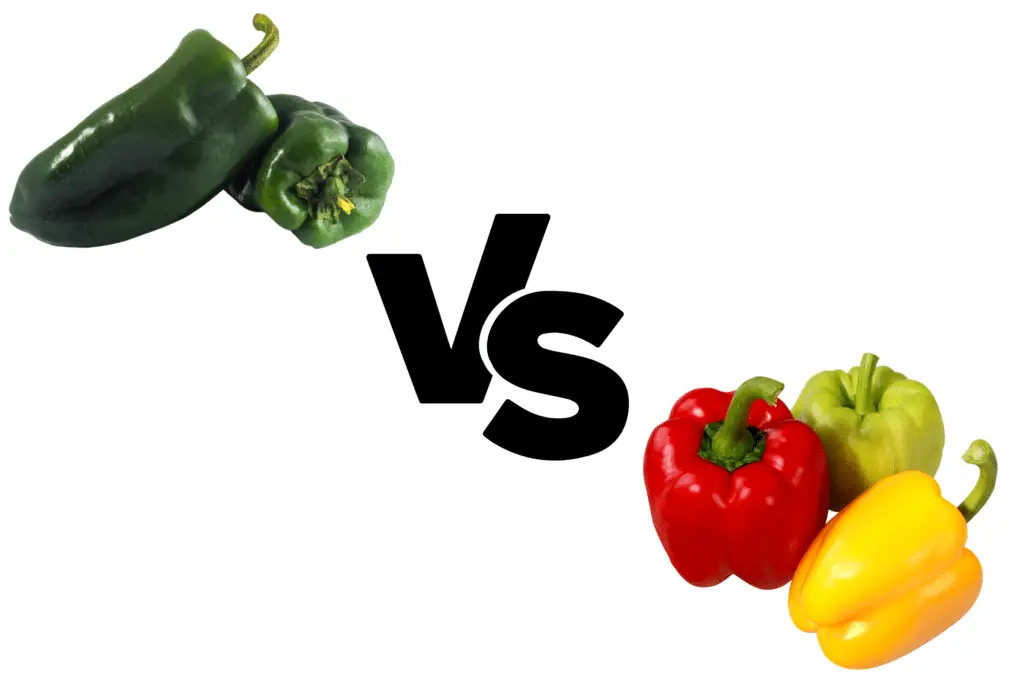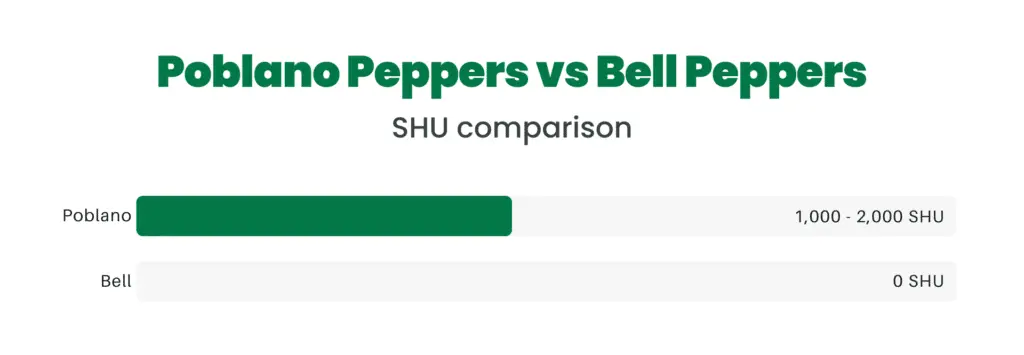Ah, bell peppers – the classic! With no heat and a juicy, slightly sweet flavor, bell peppers are a popular addition to many meals, but how do they rank up against the mighty poblano?
Poblano peppers and bell peppers are often substituted for each other, but they’re actually very different. Bell peppers have no spice to them, while poblanos have an SHU rating of 1,000-2,000. Poblanos are rich and earthy, but bell peppers are sweet and juicy. Ultimately, these differences are still subtle enough that substitution is possible!
Read on for a comprehensive rundown between these two fantastic peppers!
Comparison – Differences between poblano peppers and bell peppers
Poblano peppers and bell peppers are often used interchangeably in recipes, but are they really that similar? We’re going to find out!

Let’s look at the similarities and differences between poblano and bell peppers based on the following criteria:
- Poblano peppers vs bell peppers heat level
- Poblano peppers vs bell peppers flavor
- Poblano peppers vs bell peppers texture
- Poblano peppers vs bell peppers size and shape
- Poblano peppers vs bell peppers nutrition
- Poblano peppers vs bell peppers cost and availability
- Unique difficulties
- Substitutions
| Criteria | Poblano Pepper | Bell Pepper |
|---|---|---|
| Heat level | 1,000-2,000 SHU | 0 SHU |
| Flavor | Deep, dark, smoky | Sweet and juicy |
| Texture | Smooth and somewhat flat | Smooth |
| Size | Up to 6″ | 3-4″ |
| Shape | Relatively flat | Slightly rounded |
| Nutrition (per 100g) | 20 Calories 134% DV Vitamin C | Green: 20 calories 89% DV Vitamin C Red: 26 calories 142% DV Vitamin C |
| Substitutions | Green bell pepper | Pepperoncini pepper |
Poblano peppers vs bell peppers heat level (in Scoville heat units)
While poblano peppers aren’t considered hot in the world of spicy peppers, bell peppers have absolutely no heat, making them suitable more even the most sensitive eaters among us.
Poblano peppers range from 1,000-2,000 SHU. Bell peppers have a rating of 0 SHU. KD

Poblano peppers vs bell peppers flavor
Poblano peppers have a deep, rich, and earthy flavor.
Bell peppers are sweet and juicy.
Poblano peppers vs bell peppers texture
Both poblano peppers and bell peppers are smooth on the outside. Bell peppers are slightly juicier.
Poblano peppers have a tough outer skin that you won’t find on the easy-to-use bell pepper.
Poblano peppers vs bell peppers size and shape
Poblano peppers and bell peppers are just about the same size.
Bell peppers have a plump almost bell-like shape (hence the name); poblanos are darker in color than a bell pepper of comparable ripeness and flatter.
Poblano peppers vs bell peppers nutrition
Poblano peppers and bell peppers both have an extraordinary amount of Vitamin C.
Vitamin C is an important antioxidant that helps fight free radicals in your body, ultimately aiding in preventing cancer and increasing lifespan.
Cost and availability
Bell peppers are easier to come by and cost less than poblanos.

Green poblano peppers can be found at many grocery stores, although the ripe red variety is harder to come by.
Green bell peppers are nearly ubiquitous; you’ll pay more for yellow, orange, and red bell peppers, but they shouldn’t be hard to find.
Unique difficulties
One unique difficulty of using poblano peppers is their tough exterior. While this makes them great for stuffing, many people dislike the texture and need to peel it off.
Meanwhile, bell peppers are a bit flimsy for stuffing. It can also be difficult to find a flavorful bell pepper unless you buy local or grow them yourself.
Can you substitute poblano peppers for bell peppers or vice versa?
You can substitute poblano peppers for bell peppers, and vice versa. Poblanos will have a slight spice to them and an earthy flavor, whereas bell peppers will lack the heat and have a sweet flavor.
However, they are still easily interchangeable in many dishes.
Poblano peppers – a complete overview
Poblano peppers are a staple in Mexican dishes because of their deep, earthy flavor and are a favorite among gardeners because they’re easy to grow and yield a bountiful harvest.
Poblano peppers are popular because they imbue a meal with both flavor and a bit of heat without overwhelming the dish with spice.
Let’s take a deeper look at this versatile pepper!
Heat
Poblano peppers are widely considered the mildest spicy pepper. Their Scoville Heat Unit rating ranges from 1,000-2,000.

Capsaicin levels increase as hot peppers mature, hence the range. Even though this range might seem like a lot, some hot peppers have a much larger range!
The more mild (“immature”) poblanos are dark green, whereas the spicier mature poblanos are deep red.
Flavor
Poblanos have a rich umami flavor.
They’re smokey and earthy with a well-rounded flavor profile.
Size, shape, and texture
Poblano peppers are typically between 4 and 6 inches long.
They look like flattened bell peppers.
Poblanos have a tough exterior skin, meaning they’re difficult to eat raw.
Nutritional content and potential health benefits
One cup of raw poblano peppers has:
- 30 calories
- 14% DV dietary fiber
- 30% DV Vitamin B6
- 134% DV Vitamin C
Potential health benefits of poblano peppers include:
- Decreased inflammation
- Immunity boost
- Increased lifespan
Cooking with poblano peppers
Poblano peppers are perfect for stuffing because of how strong they are.

Likewise, blistering them is a great way to draw out their naturally deep, rich flavors.
You can also saute, grill, or roast them.
While some people like raw poblano peppers, others can’t get past the tough exterior.
Are you ready to try blistering your poblanos? Check out this article for 4 great ways to get the most flavor from your pepper!
Substitutions for poblano peppers
Bell peppers are a good substitution for poblano peppers, although bell peppers are much sweeter and aren’t spicy.
Freezing, drying, and preserving poblano peppers
You can freeze, dry, and pickle poblanos to preserve them.
Bell peppers – a complete overview
Bell peppers are probably the most common of the wide variety of peppers, although it may seem like they don’t get a lot of love.
Bell peppers are incredibly versatile and bring a nice flavor to most dishes without imparting any heat. They can be eaten raw, roasted, sauteed, and more meaning they’re both a healthy snack and an excellent addition to many recipes.
Let’s find out all about this yummy vegetable!
Heat
Bell peppers have 0 SHU.
That means that, unlike most other peppers, they’re not spicy at all.
Flavor
Bell peppers are sweet and juicy.
Red, orange, and yellow bell peppers have more flavor than green ones.
Size, shape, and texture
Bell peppers are usually 4-5 inches long.
They have a rounded shape with multiple lobes.
Bell peppers are smooth on the outside and burst in your mouth.
Nutritional content and potential health benefits
One bell pepper contains:
- 37 calories
- 8% DV dietary fiber
- 75% DV Vitamin A
- 253% DV Vitamin C
Bell peppers may:
- Help lower blood pressure
- Reduce your risk of heart attacks
- Promote healthy stools
- Reduce your risk of diabetes
Cooking with bell peppers
Bell peppers can be cooked any which way – sauteed, grilled, roasted, blistered- you name it!
Bell peppers can be stuffed, but they’re likely to break down while being cooked. Personally, I prefer to stuff poblanos because of their firmer skin.

Bell peppers are also the most common pepper to eat raw. They’re frequently eaten with hummus, on salads, or on their own!
Substitutions for bell peppers
The best substitution for a bell pepper is an Anaheim pepper because of its low SHU and sweet flavor. You can also substitute poblano peppers if you want a richer flavor.
Freezing, drying, and preserving bell peppers
Freezing, drying, and canning bell peppers are all fun activities that can transform the shelf life of your peppers from 2 weeks to years on end!

